How to grow indoor pomegranate Bonsai
The pomegranate is called the “tree of life.” This beautiful plant with small leaves and bright flowers produces tasty and healthy fruits. Of them seeds You can grow pomegranate at home. If in nature it reaches a height of 6 m, then at home the plant will not exceed 1 m. A tree in a pot will produce fruits with a diameter of up to 8 cm.
Indoor pomegranate looks especially aesthetically pleasing during flowering and fruiting periods. In order for the plant to become a full-fledged element of the interior and look interesting, even when there are no flowers or fruits on it, it is worth trying to grow a bonsai. Forming a trunk will require time and attention, but following the step-by-step instructions and our recommendations, you will definitely cope with this task.
What is bonsai
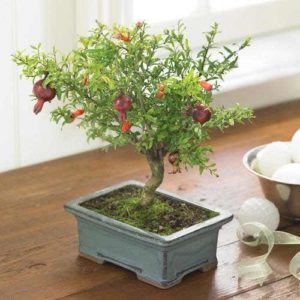
The word "bonsai" (盆栽) literally means "grown in a tray" in Japanese. This is the name given to miniatures of real trees or shrubs.
Many people think that bonsai are obtained from special dwarf varieties. Actually this is not true. Miniatures are obtained from the most ordinary trees and they can be grown from a seed extracted from a fruit purchased in a store. The compact size of the plant is due to the limited growth of the root system, which is achieved by choosing small containers.
There are more than 17 styles of bonsai shaping. The most popular option is with a curved long trunk and an unusually shaped crown. This effect is achieved by trimming leaves and shoots and forming a curved trunk.
In Japan, they believe that bonsai masters should be not only gardeners, but also artists. After all, their task is to show all the beauty of nature in one tree.
Bonsai is grown from grenade. The plant takes root well at home, has beautiful bright green medium-sized leaves and red, silk-like flowers. Even on a windowsill, the tree will produce small fruits, complementing the beauty of the bonsai.
This is interesting! Bonsai are made not only in home pots, but also in the garden.
Planting seeds
The first stage of growing a bonsai is not much different from planting a regular tree. However, there are still some nuances in this process.
Selection and preparation of indoor pomegranate seeds
To grow a miniature pomegranate tree at home, use seeds or cuttings. Seed planting material is preferable, since in this case it is easier to form a trunk.
The most common way to obtain the seeds is to remove them from a commercial pomegranate fruit. In this case, when choosing planting material, adhere to the following rules:
- The fruit should have a regular round shape and red color. It is important that there are no green spots, rot, mold, damage or signs of disease on it.
- The pulp around the seeds is rich red. Specimens with white or green flesh are not suitable.
- The seeds themselves should be white or cream in color. It is important that the planting material is hard and smooth. Soft seeds with signs of disease or green color will not be suitable.
The seeds are carefully removed from the pulp by hand. It is important not to damage them.
Pomegranate seeds do not have the highest germination rate. Therefore, if you plan to grow 1 pomegranate, take at least 10 seeds.
Note! In most cases, pomegranate hybrids are sold on store shelves. Seeds from such fruits will germinate, but will produce ordinary fruit. Their fruits will be small, light red, with a sour, tart taste.
The second option for obtaining planting material is to purchase dwarf pomegranate seeds. Such plants are initially short in stature and are suitable for growing indoors. The best varieties for planting in a pot include: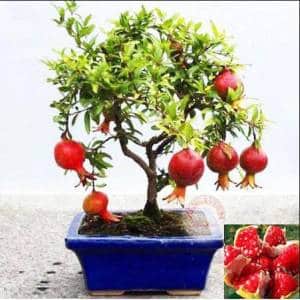
- Baby;
- Ruby;
- Uzbekistan;
- Shah-nar;
- Carthage.
Seeds intended for planting, purchased in a specialized store, are processed in a factory. This is evidenced by the inscription on the packaging.
Planting material, independently collected from fruits, requires preliminary preparation for planting. It includes the following steps:
- Cleaning from pulp. The seeds are soaked in warm water for 30 minutes. and cleared of pulp. Specimens that sink to the bottom have a much greater chance of germinating.
- Disinfection. Planting material is soaked for 30 minutes. in a light pink solution of potassium permanganate.
- Growth stimulation. The seeds are soaked in a solution of a growth stimulator (Epin, Mortar) for 12 hours.
During soaking, place the container with seeds in a cold place without drafts.
Soil and planting container
For growing For pomegranate bonsai, loose, slightly acidic or neutral light soil is best suited. However, a tree grows in any soil. It is sold in gardening stores.
Preference is given to universal soil or soil mixture for begonias and roses. To prepare the soil yourself, mix in equal proportions:
- turf;
- humus;
- sand.
Add 2 tbsp to the soil mixture. l. ash. Some gardeners additionally use superphosphate.
Both purchased and homemade soil are disinfected. To do this, it is calcined in the oven, poured with a dark pink solution of potassium permanganate or a hot solution of copper sulfate.
In addition to soil, it is recommended to use drainage. Broken ceramics, small crushed stone, crushed expanded clay, and shell rock are suitable. The drainage is also disinfected.
First, the seeds are sown in one common container. For this use:
- wooden boxes;
- plastic trays;
- cut plastic bottles, etc..
After germination, the strongest seedlings are selected and planted in separate containers. The pot plays an important role in the formation of a bonsai. It is this that limits the growth of the root system and makes the tree miniature. It is recommended to choose shallow but wide containers of any shape, resembling pallets, for the plant. A height of 4-10 cm is sufficient.
All containers are disinfected. They are sterilized with boiling water or soaked for 30 minutes. in a dark pink solution of potassium permanganate.
Important! There should be drainage holes in the bottom of containers for growing pomegranates.
Sowing seeds and care before picking
Their germination and viability depend on the correct sowing of seeds.
Step-by-step instruction:
- A layer of expanded clay is poured onto the bottom of the box. The rest of the volume is filled with soil mixture.
- The soil is watered with settled water at room temperature.
- Grooves 1-1.5 cm deep are made in the ground at a distance of 3 cm from each other. Seeds are placed in them, leaving a space of 3 cm free.
- The containers are covered with film or a transparent plastic lid (for example, the top of a cake package or the remains of a cut-off bottle) and placed in a warm, bright place.
Every day the film is opened slightly for 30-120 minutes. As the soil dries, it is moistened with a spray bottle.
note! The timing of the appearance of the first shoots is impossible to predict. Pomegranate seeds germinate from 1 week to several months. It is believed that planting material sown in November or February germinates faster.
It is important to provide the seedlings with proper care: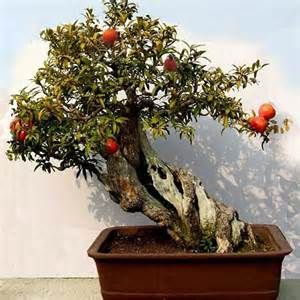
- Ventilation. When the first shoots appear, the plants begin to ventilate, gradually increasing the duration of this process. When 2 real leaves appear, the improvised greenhouse is dismantled.
- Watering. The seedlings are watered from a spray bottle with warm, settled water as the top layer of soil dries. It is important not to let the soil dry out, but also not to flood it.
- Loosening. After each watering, the soil is loosened, destroying the earthen crust.
- Lighting. In spring, summer and autumn, seedlings do not need lighting. In winter, it is recommended to illuminate the pomegranate with a phytolamp so that its daylight hours are 12 hours.
When 3-4 true leaves appear on the plants, they are picked into separate containers. Select sprouts with bright green foliage, dense stems and good turgor. Pale weak specimens are thrown out.
The pot is filled according to the same principle as when sowing seeds: first, a layer of drainage is poured, and then soil. The soil is watered with warm, settled water. The seedlings are also watered.
The selected seedlings are carefully removed from the box with a teaspoon or wooden stick along with a lump of earth, trying not to damage the roots. The pomegranate is moved to an individual pot. It is sprinkled with soil without deepening the root collar. The plant is watered and placed in a sunny place.
Important! For the first 2 days after transplanting, the pomegranate is not watered, allowing it to take root.
Forming a Pomegranate Bonsai Tree
How to make a bonsai from an ordinary pomegranate? In fact, a tree grown in a shallow flower pot is already a bonsai. However, a real bonsai means a plant with a beautifully curved trunk and a curly crown.
To achieve this effect, the trunk is artificially formed and the crown is trimmed. It is this process that is considered the most difficult in growing bonsai.
Trunk
To make a bonsai out of an ordinary indoor pomegranate with your own hands, it is important to correctly form the trunk. There are areas that do not require this process, but it is trees with a curved trunk that look especially interesting.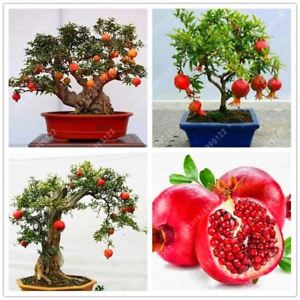
The trunk begins to form before its bark becomes too hard. Otherwise, there will be scars on it that will take a long time to heal.
The trunk is formed by winding copper wire from the base up to the first branch. The wrapping should not be too tight so that the lower bark does not crack.
After the wire is wound, the barrel is bent along with it. Usually make 2-3 not too sharp bends or turns.
Advice! 1/3 of the trunk should be completely bare. The ideal proportion of the thickness and length of the trunk is 1/7.
If desired, you can thicken the trunk. To do this, a tight winding is made in the area where the seal should end. The purpose of the wire is to slow down, but not block the flow of sap. When the thickening is formed, the wire is removed.
If the tree turns out to be too tall, then it is transplanted into a pot, burying the trunk to the desired level. A year later, when a sufficient number of roots have formed in the buried area, the tree is replanted, cutting off the old root system.
Pruning branches
Crown formation also plays a role in bonsai growing. The tree should have small leaves and an aged appearance.At the same time, too thick a crown is harmful to pomegranate, as it promotes the formation of mold.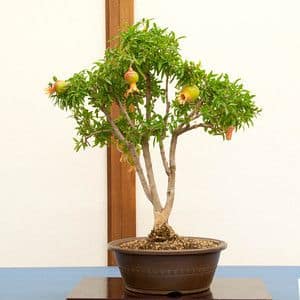
3-4 branches and a top are left on the main trunk. In this case, the distance between the branches should be large. Each branch is limited to a growth point when it reaches the desired size.
To increase the amount of foliage and reduce the size of the leaf blades, 1 and 3 leaves are regularly torn off. During the growing process, the tree is rejuvenated by cutting off old foliage.
When growing bonsai, it is recommended to draw up in advance a diagram of the tree that should end up. This will make it easier to form the crown.
Typically, the lower branches closer to the trunk are left bare, and abundant foliage is grown at the ends. The higher the branches, the more foliage and shoots are left on them.
The crown is shaped by cutting. Pomegranate tolerates this process well. Thick branches are given shape and direction using wire. This is done until the bark becomes woody.
How to care for a pomegranate bonsai tree
In order for a bonsai to grow for decades, it is important to regularly care for it:
- Watering. The pomegranate is watered as the top layer of soil dries. In shallow, wide containers this happens faster than in regular deep pots. Water with warm, settled water so that the soil is moistened but not flooded. In summer, the soil is moistened more often than in winter.
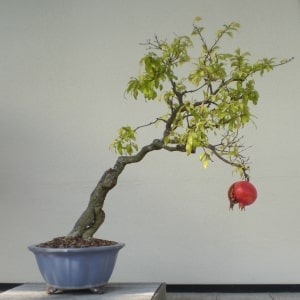
- Trimming. Once every 2-3 years, weak, diseased and dry branches are removed. Old large leaves are periodically picked off.
- Transfer. The bonsai is transplanted into a new container every 3-4 years. The new pot should be slightly larger and deeper than the previous one. When replanting, the trees are cut back by 1/3, removing dry and old shoots.
- Temperature. In summer, pomegranate feels comfortable at a temperature of +20...25°C.In winter, it is recommended to reduce the readings to +12…15°C.
- Bloom. During the first flowering, the flowers are cut off so that the plant does not die. To get fruits, it is recommended to additionally pollinate the flowers with a brush.
- Feeding. From early spring to mid-autumn, fertilizing is applied once every 1-2 weeks, alternating special fertilizers for pomegranate or bonsai and chicken manure diluted 1:10. In winter, pomegranates are not fed.
In winter, pomegranate sheds its leaves.
This is interesting:
A step-by-step guide to propagating pomegranate from cuttings at home.
What is the difference between clementines and tangerines and which is healthier.
Conclusion
Pomegranate bonsai is a beautiful and unusual plant. It looks interesting and aesthetically pleasing at any time of the year. During flowering, it is decorated with orange flowers, the petals of which resemble silk, and during fruiting, it is decorated with round, bright red fruits.
Growing a bonsai from pomegranate seeds is easy. The only difficulty lies in the formation of the trunk and crown. For beginners, it is better to draw up a project for the desired tree shape in advance and practice on several plants at once.